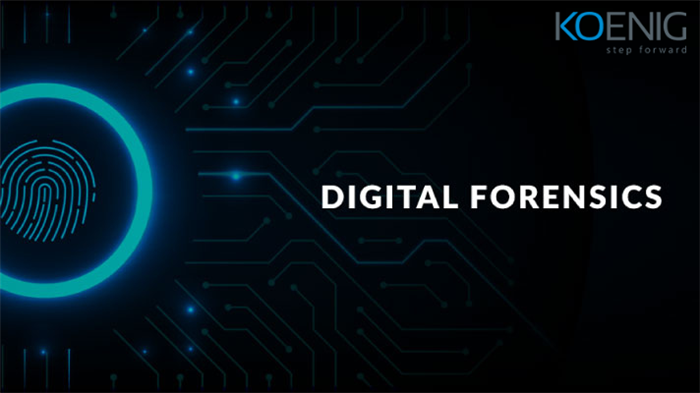We're open through the holidays to support your upskilling goals — book your session today!
We're open through the holidays to support your upskilling goals — book your session today!
Unable to find what you're searching for?
We're here to help you find it
The rate of cyber crimes has increased dramatically in recent years. Cybersecurity Ventures predicted an increase in cybercrime costs by 15 per cent in the next five years. Ever wonder how people behind these cyber crimes are caught? Just like criminals leave behind clues in physical crimes, cyber crimes also have digital traces such as timestamps, metadata, and file fragments that you can follow to find the attacker. Digital forensics investigators pursue these.
But what is digital forensics? Read on to find out more.
Digital forensics, also called digital forensic science, is a branch of forensic science focusing on cybercrime investigation. Forensics use science to solve criminal and civil crimes. Digital forensics is a science that helps find evidence from all digital devices, such as computers, tablets, etc. The word digital forensics was earlier used as a synonym for computer forensics, but it has evolved to cover all types of digital devices.
With increasing cybercrimes, the digital forensics market has also grown. Future Marketing Insights anticipates the global digital forensics market growing at 11.2 per cent CAGR between 2022 and 2030. Digital forensics investigators are responsible for investigating and collecting evidence after committing a cybercrime. It is also used in court and law enforcement.
To become a digital forensics investigator, you need a Bachelor's degree in Engineering, Computer Science, or Cybersecurity. Getting a Master's in Cybersecurity with a special focus on Digital Forensics will give you an edge.
There is no doubt that digital forensics is crucial for the world. The internet is an inseparable part of our lives, and as long as we depend on the internet, digital forensics will continue to be important. Every day we generate a substantial amount of data and permit companies to use that data to provide better services. A data breach is not an uncommon crime in the cyber world. And while we cannot recover the data breach, we can catch the criminal and get them punished.
Some of the other things that digital forensic do are:
● Identify the cause of a cybercrime
● Protects the evidence left behind during the crime before it becomes useless
● Locating unauthorized logins
● Identify the duration for which someone had unauthorized access
● Help recover data during data loss
● Gives a digital forensic report on the investigation process
● Help deal with ransomware attacks
You can use digital evidence collected by digital forensics investigation can be used in legal proceedings for data theft, identity theft, online fraud, network breaches, violent crimes, and even white-collar crimes.
Without employing digital forensics, organizations risk facing continuous damage and providing unauthorized access to attackers. This will result not only in financial and reputation loss for the organization but also in legal troubles. Releasing personally identifiable and sensitive information can easily make companies pay millions in compensation. Organizations will also lose their competitive advantage if trade secrets are stolen, erased, or released to competitors.
Digital forensics follows five steps - identification, preservation, analysis, documentation, and presentation. Let's take a look at each one of them.
● Identification
The first step of digital forensics is identification. This includes identifying the evidence and searching for its position and format. The goal is to identify the evidence left by the cyber attacker after a cybercrime.
● Preservation
Digital evidence is easy to tamper with, so protecting it is crucial. In this step, the investigator isolates, secures, and safeguards the obtained evidence to ensure its authenticity.
● Analysis
This step includes using evidence to analyze and draw conclusions about the crime. The investigators also reconstruct the data fragments to find out the cause and intent of the attack. The goal is to determine who created the data, who edited it, and when these activities occurred.
● Documentation
Documentation involves creating a record of all the data and evidence found. This enables investigators to recreate the crime scene and map it.
● Presentation
The last step, presentation, involves presenting all the details and evidence found with a summary and conclusions drawn. The presentation enables everyone to understand the details of crime easily.
The primary purpose of digital forensics is to assist in criminal and civil cases. Criminal cases involve the investigation of cybercrimes by law enforcement agencies or digital forensic investigators. Civil cases are about protecting the rights and properties of businesses and individuals. Organizations hire digital forensics experts to identify and respond to cyber threats. They are also used in incident response teams in data loss or breach cases.
There are several types of digital forensics. We have discussed the primary ones below.
● Computer forensics
Computer science forensics deals with the evidence available in computers. The investigation aims to identify, preserve, analyze, document, and report the findings from digital storage media. This branch of forensics is used in civil and criminal cases, and the evidence found through this investigation goes through the same processes as other digital evidence. The process is similar to data recovery techniques except for the additional practices that aid in creating an audit trail.
● Network forensics
This branch is focused on the collection of data and evidence from networks. It monitors and analyzes computer networks to detect any intrusion. The difference between this forensics and other branches is that network forensics is highly volatile and dynamic because of the nature of network data. Once network data is transmitted, it is gone permanently, which makes network forensics an extremely proactive investigation.
● Mobile device forensics
This branch of digital forensics focuses on recovering evidence from mobile phones. Mobile phones don't only include the phones we use daily but also GPS devices, tablets, and PDA devices. Mobile device forensics is one of the most challenging fields of digital forensics because of the frequent changes in mobile form forms, storage capacity growth, and other technical challenges. There's not a single tool that you can use to extract all the information from a mobile device which has made forensics even more challenging.
● Database forensics
Database forensics is used for investigating databases and metadata. An example of database forensics is identifying specific transactions in a database that may show fraudulent activities. The investigators inspect the validity and authenticity of databases under this forensics.
● Forensic data analysis
Forensic data analysis, or FDA, is concerned with financial crimes. It examines structured data to identify and analyze patterns that may indicate fraud. This analysis is focused on the data itself rather than the database. If the focus is on databases, then database forensics is applied. The results are typically shown by data visualization.
There was a time when digital tools barely existed. The tools were inadequate to extract admissible evidence. But with the advancement in technology, digital forensic tools have also advanced. Tools like Wireshark, HashKeeper, and packet sniffer are now available everywhere. Investigators can also use the dedicated Linux distribution for digital forensics.
Some of the types of digital forensic tools currently used are:
● Email Analysis Tools
● Mobile Device Analysis Tools
● Registry Analysis Tools
● File Viewers
● Internet Analysis Tools
● Database Forensics Tools
● Computer Forensics Tools
The following aspects are considered while evaluating these tools:
● Graphic UI, ease of use, and CLI (command line interface)
● Compatibility with additional integrations
● Device types and file formats supported by the tool
● Types of configurations
● Training to help use the product
Digital forensics has both advantages and disadvantages. Let's take a look at some of them.
Advantages
● Digital forensics helps find digital evidence, permissible in the court and can lead to punishing criminals.
● It helps in protecting businesses' resources, time, and money.
● It ensures the integrity of digital systems.
● It is capable of tracking the criminal behind various cyber crimes.
● It helps in identifying, analyzing, and preserving important evidence.
Disadvantages
● While digital evidence is admissible in court, investigators have to prove that the evidence was not doctored.
● The entire process of digital forensics can be expensive.
● The tools and techniques used in the investigation must match the standard set by the court. If they don't match, then the evidence becomes useless.
● Investigators must be highly qualified and knowledgeable to get desired results.
A digital forensics investigator is a person who identifies the evidence to solve a digital crime. How did the criminal gain access to the network? How did the crime happen? Is there any malware present in the system? What did the criminal do while inside the network? They look for answers to these questions. They recreate the crime and also recover data lost.
Digital forensics analysts typically work with law enforcement agencies, governments, police, and companies. They use digital forensic tools and techniques to investigate cyber crimes. Digital forensic investigators can work in the following roles:
● Security forensics analyst
● Digital forensics analyst
● Senior consultant, digital forensics
● Cyber forensics investigator
● Cybersecurity forensics consultant
● Forensics engineer
To become a digital forensics investigator, you need a Bachelor's degree in Engineering, Computer Science, or Cybersecurity. Getting a Master's in Cybersecurity with a special focus on Digital Forensics will give you an edge. SAN offers GFCA (GIAC Certified Forensic Analyst) certification for people who want extra knowledge and experience in this field. EC Council also offers CHFI (Computer Hacking and Forensic Investigator) certification for people who aspire to become cyber professionals. These certifications also give you an edge while applying for jobs.
Digital forensics is integral to maintaining safety on the internet. It is also integral to companies that deal with sensitive data and customers. Having a digital forensics expert in your company gives you a greater chance of identifying the attacker in case of any cyberattack and protecting your reputation.

Aarav Goel has top education industry knowledge with 4 years of experience. Being a passionate blogger also does blogging on the technology niche.










